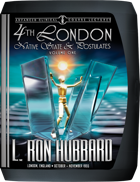
AXIOM OF THE STABLE DATUM
Know And Not-Know
With requests for L. Ron Hubbard’s books now arriving from locations as distant as Cairo and Tel Aviv, Mr. Hubbard determined that a more central location was needed to monitor the growth of international Scientology. Thus was established the Founding Church of Scientology in Washington, DC. Moreover, with that new Church came something else: the first Scientology Academy—the Academy of Religious Arts and Sciences. While these organizational developments marked a first, the story of technical advance likewise presented a monumental picture. Specifically, with the discovery of one of the most far-reaching principles in Scientology, Axiom 53 (the Axiom of the Stable Datum), L. Ron Hubbard had found an answer to all aberration and the basic theory of sanity or ability. And making its entrance in step with Axiom 53 came another milestone—the four postulates that let the thetan to his fall from native state and the processes for their resolution. Mr. Hubbard concurrently hatted auditors on how to disseminate, providing them with The Scientologist: A Manual on Dissemination of Material, and an article, “Start That Practice!” in which he detailed how to carry the torch for success.
Read MoreMORE ABOUT AXIOM OF THE STABLE DATUM
So we have postulate one, Not-Know (this is on an analytical level); postulate two, Know; postulate three, Forget; and postulate four, Remember. —L. Ron Hubbard
By the summer of 1955, the Hubbard Association of Scientologists International in Phoenix had grown to eight buildings and a sizeable full-time staff. As for why, with ACC graduates now spearheading expansion across their geographic zones, the combined force of Scientologists was making their influence felt across the planet. British Scientology, with five hundred auditors, stretched from Liverpool in the north of England to Croydon in the south. Auditors by the dozen were training in South Africa. Scientology had taken root in Australia and New Zealand was booming. Nor was that all. News of L. Ron Hubbard’s breakthroughs had circulated so broadly that requests for books came in from locations as distant as Tel Aviv and Cairo. All the while, coast to coast in the United States, expansion continued to drive forward.
Realizing that a more central location was needed to monitor the growth of international Scientology, Mr. Hubbard decided to move to Washington, DC. Thus, in July 1955, with a Distribution Center established in nearby Silver Spring, Maryland, to publish and disseminate the materials, the Founding Church of Scientology was established at 1845 “R” Street NW. More to the point, that new Church also saw the establishment of the first Scientology Academy—The Academy of Religious Arts and Sciences.
If the era was marked by a series of organizational “firsts,” the story of technical advance was the same. For with an entire arsenal of processes now in use—from both The Creation of Human Ability and Dianetics 55!—Ron had made a new discovery not only applicable to all auditing, but to the entire concept of Knowingness that had driven Man’s quest for some thousands of years. Hence, on 11 July 1955, he began delivery of the Washington Academy Lectures. Opening with a detailed description of modern auditing procedures, he continued with the application in auditing of four key postulates made by the thetan. And for those students, a single lecture title left none in doubt about the magnitude of these discoveries: “The Unknown Datum—A mest Shaking Lecture.”
“With the arrival of the concept that the highest knowingness that you can reach is not to know about anything, we have crossroaded with all of the philosophies of the East and have gone beyond. We just left the human race.
“This idiotic secret was the secret that held this universe together.”
For, making its bow in tandem with the four postulates was what would become one of the most far-reaching principles of Scientology: Axiom 53, or as Mr. Hubbard described it, “the Axiom of the Stable Datum.” As to the role Axiom 53 and the four postulates played in auditing, it was truly fundamental. As he explained:
“They’re the two basic decisions of this universe: Survive, Succumb. And those are the two stable data.
“He’s lying in a hospital bed, he’s living in misery and pain and he reads Dianetics: Evolution of a Science or something like that and he all of a sudden says, ‘Hey! Wait! This—bang!’ and he gets up and he’s not sick anymore. Magic! Pure magic! It really is one of the two stable data.
“Now, the other stable datum, tiny bit less magnitude, is Succumb, see? Just those two. Now, those are the two data on which life aligns itself and any misalignment with those two data will result in aberration.”
Hence, central to Axiom 53 was how to audit preclears to the point of being able to alter, change or shift stable data:
- Rugged Individualism—if one did not have to consistently protect one individuality, he would recover free choice in life;
- Unconsciousness—as a lower harmonic of not-knowingness;
- Rememberingness—as a harmonic of knowingness;
- Insanity—its mechanics, and why it is a chaos in which no stable data exists;
- Chaos—how it supports and gives power to the stable datum on a reactive level;
- Ideal State for a Thetan—to forget and remember selectively—and how Scientology is a method by which an individual can Know or Not-Know at will.
As to what these advances meant in terms of disseminating, Mr. Hubbard declared he wanted every Scientologist three feet behind society’s head in his own community. Or, as he wrote in a letter to accompany an early September 1955 edition of Ability magazine:
“With this issue and material under development, the goals, the rosiest ones, of Dianetics and Scientology are becoming an actuality.
“We can win by commanding the environment against a school of thought—Miceology—which only conforms to it.”
Toward that end, L. Ron Hubbard instructed auditors on how to disseminate—specifically providing them with The Scientologist: A Manual on the Dissemination of Material, on how to conduct a field activity, and “Start That Practice!”—urging auditors to carry the torch and telling them how to be a success. Thus, as fall 1955 arrived, with a centrally located Founding Church of Scientology, a fully functioning Academy and the resources for dissemination at hand, Scientology stood poised for its next, entirely new phase of expansion.




